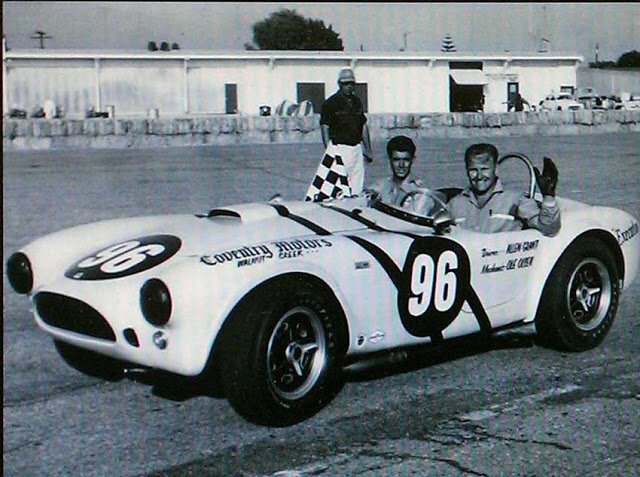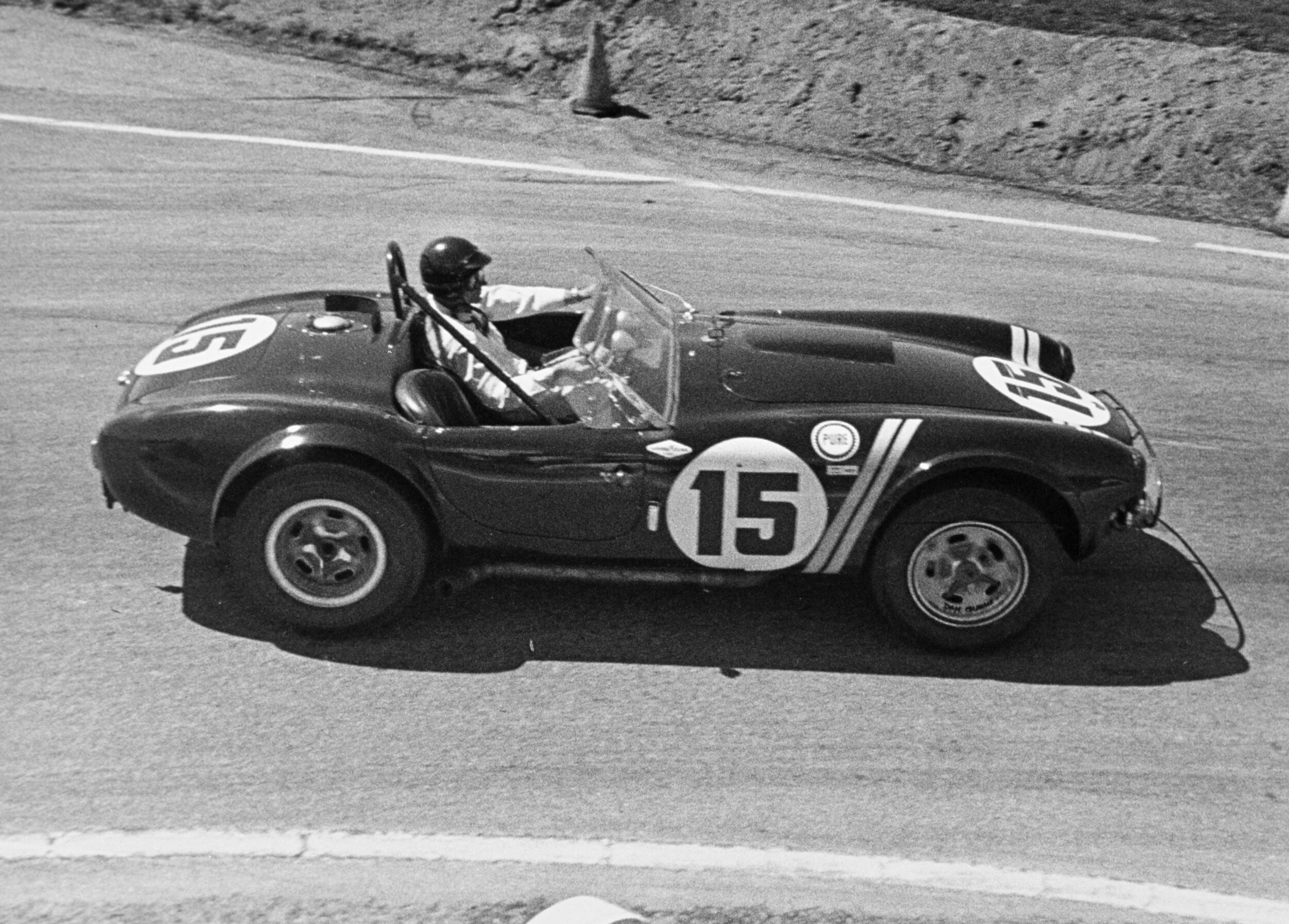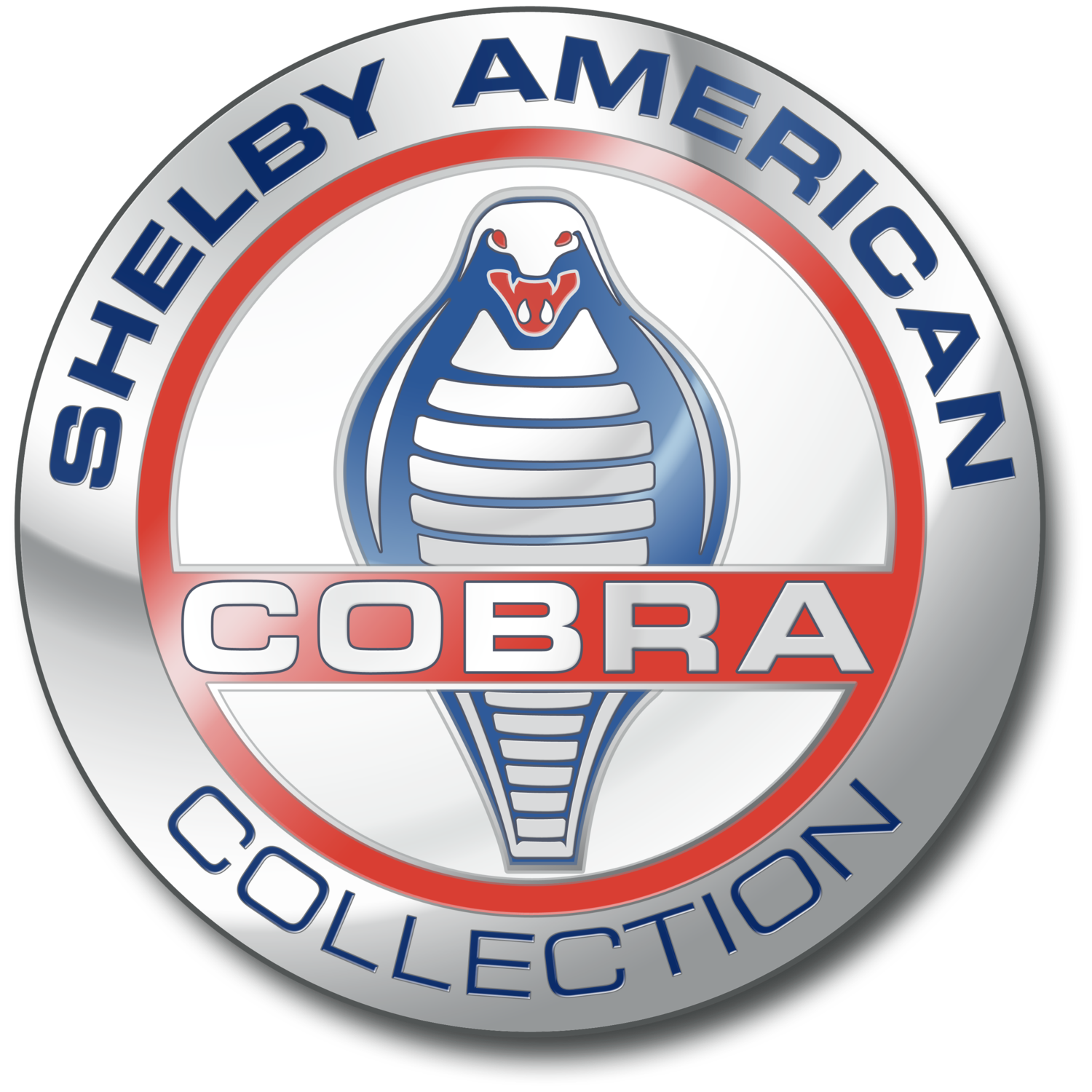1963 Cobra Roadster CSX2128
The Sebring Cobra







Details & History
Being one of the three team Cobras at Sebring in 1963—and raced there by Dan Gurney in his first Cobra drive—certainly made this car significant, but it gained equal publicity by appearing on the cover of the 1963 LP “Hey Little Cobra” by the Rip Chords. Not only that, but this car has one of the longest team competition histories of any Cobra: it went to its first race in March 1963 and its last in March 1966.
Set apart in black with distinctive yellow stripes, CSX2137 was the prettiest Cobra on America’s tracks in 1963. Before Sebring, two rearview mirrors were positioned behind the slant-back windshield, and a splash guard was fitted around the fuel filler, along with
a chrome roll bar and a single windshield wiper. The fenders had no vents, and the top of the driver’s door was cut back for arm clearance. Because the body could twist enough under hard cornering to unlatch the trunk lid, which could cause a black flag during a race, a bungee cord hooked into a pair of sockets below the latch served as extra security.
Besides being the first race Cobra fitted with a 289 V8 engine as original equipment, it was also the first racer with rack-and-pinion steering. of course, both proved to be huge advantages, and several drivers who raced worm-and-sector-steering cars, including Bob Johnson, sold their early mounts and bought one of these better-steering cars.
For the 1963 edition of the Sebring 12 Hours, Shelby American entered four well prepared Cobras (Holman-Moody entered one), complete with radiator and driving light guards. CSX2128 was allocated to Dan Gurney, Lew Spencer, and Dave McDonald. To make the black car easier for the crew to distinguish at night, Peter Brock applied the stripes , with a spray can. Alas, CSX2128 pulled up lame with a leaking rear main oil seal and was classified 22nd in class and 28th overall.
Thankfully, that was the car’s worst-ever finish. That summer, after Bob Holbert scored a fourth in A Production in it in an SCCA race at Virginia International, CSX2128 went back to McDonald, who warmed up with it in an SCCA Regional on at Cotati, California. Winning the A Production class at the flat, airport-based track, he finished a full 48 seconds ahead of his nearest competitor!
More challenging USRRC events followed at Pensacola (DNF), Laguna Seca (2nd, GT; 7th overall), and Watkins Glen (3rd, Manufacturers Championship). In July, McDonald and CSX2128 took part in the Great Corvette Ambush at Lake Garnett, Kansas (see CSX2026), finishing second.
After tossing off a win in a mere SCCA regional race at Pomona, possibly as another test run, the pair was off to Kent, Washington, in July. There they finished fifth among the over-2.0-liter cars but first in the drivers’ championship, lapping the rest of the field, including Bob Holbert and Ken Miles.
In August 1963, Shelby American sold the car to one of its biggest dealers, Coventry Motors in Walnut Creek, California. The car was repainted in yellow with black diagonal stripes to a design by 19-year-old George Lucas, who went on to produce the movie
American Graffiti, among others. As the team’s driver, Coventry named 23-year old Allen Grant, who had won SCCA’s 1962 West Coast Rookie of the Year title in his AC Ace- Bristol. A Shelby American employee, Grant had started as a welder, worked on the pit crew, and had just been put in charge of ordering cars from A.C. According to him, the Executor nickname on the rear fenders signified that it and the driver were “in total control.”
Grant kicked off his drives in CSX2128 with two quick wins, one in an SCCA Regional at Santa Barbara, the other in a Divisional at Candlestick Park, where he lapped all but the second-place car. At the Times Grand Prix at Riverside that october, he finished second, and at the Pacific Grand Prix at Laguna Seca he won his class even though he was slowed by a tightening wheel bearing. The next day Grant was drafted and, ironically, assigned to nearby Fort ord. That didn’t end his Shelby American drives, though; eventually he served as a team driver in the Daytona Coupe.
In March 1964, the car was traded back to Shelby American and again became a team car, this time in Princess blue, with wider wheels and bigger rear fender flares. After finishing second in the Pensacola USRRC race under Graham Shaw in April, CSX2128 went to Ken Miles, who raced it five times during the rest of the 1964 season, winning at Phoenix, Riverside, and Kent. He came second at Laguna Seca, but after winning the pole at Mosport, Miles suffered a rare DNF.
That August, Shelby American sold CSX2128 for the second time, to racer Pete Harrison of Atlanta, Georgia. As usual, Shelby billed Ford for the difference between the car’s original cost and its eventual sale price. Harrison ran it, now maroon, in three more USRRC events that summer and fall—Mid-ohio, Road America, and Bridgehampton—with mixed results, his best being a third in the GT Class at Road America in September, when he shared the driving with Art Huttinger.
The car’s last chance at team competition came at Sebring in March 1965, as a reserve entry for Harrison and Linley Coleman, but since none of the starters failed to take the green flag, CSX2128 didn’t race. Its remarkable 23-race Shelby American career ended with nine first-places, six seconds, two thirds, and just two DNFs.
After Harrison sold the car in 1965, the new owner installed a 427 engine and tried his hand at drag-racing. It didn’t work, and the car moved on in 1968, sold with a 427 and a 428 engine, on a trailer outside a drag strip, for just $2,000. By the end of the 1970s the car was little more than an incomplete mess, missing many pieces, including its original body. Several potential buyers reportedly declined, deciding that it was not even a Cobra! By the mid-1980s, though, CSX2128 had been restored by Bill Murray, a new body being substituted for the missing original; only the original hood, trunk lid, and doors remained. Sold again in 1995, the car was further restored by Bill for then-owner Dave Furay and took its place in the Collection in 1997.
Text excerpted from “Shelby Cars in Detail, Cars of the Shelby American Collection” by Frank Barrett with photography by Boyd Jaynes.
Images by Boyd Jaynes, Dave Friedman and the Shelby American Collection.
On loan from the Miller Family Automobile Foundation.
Race History
1963 Race Season
Track: Sebring
Place: 29th
Driver: Phil Hill/Dan Gurney
Track: Cotati
Place: 1st
Driver: Dave MacDonald
Track: Pensacola
Place: DNF
Driver: Dave MacDonald
Track: Laguna Seca
Place: DNS
Driver: Dave MacDonald
Track: Laguna Seca
Place: raced
Driver: Dave MacDonald
